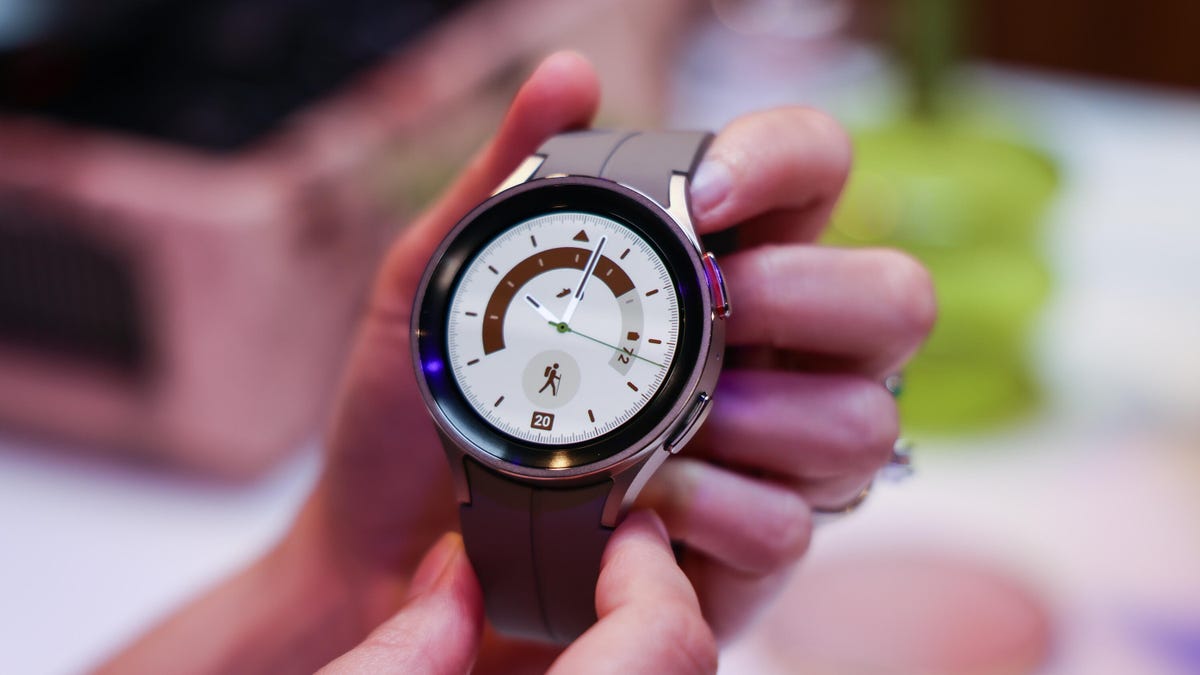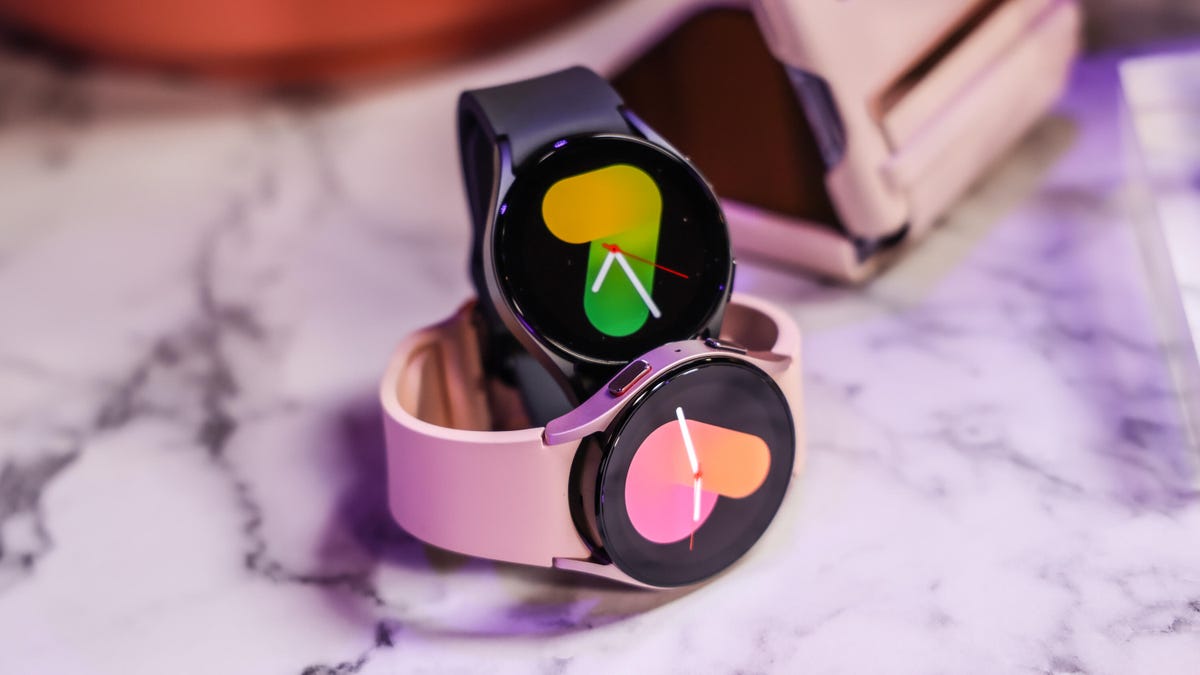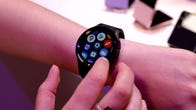Table of Contents
What’s happening
Samsung’s newest watches, the Galaxy Watch 5 and Watch 5 Pro, are arriving Aug. 26. They feature better battery life and skin temperature sensors, and promise more durability.
Why it matters
Last year’s Samsung watch was the debut of Google’s new Wear OS, and smartwatches are in search of better battery life. But Google’s Pixel Watch is also coming this fall.
What’s next
Samsung’s preorders for the watch start now, but stay tuned for our full review. Meanwhile, many more competing watches are expected later this year.
The Galaxy Watch 5, revealed at Samsung’s Unpacked event Wednesday, is the company’s latest attempt to make the ultimate Android watch following last year’s Galaxy Watch 4. This time it’s coming with a bigger Pro model to go with it, with both models set for an Aug. 26 release alongside the new Galaxy Buds 2 Pro, Galaxy Fold 4 and Flip 4.
Last year’s watch served as the debut of Google’s new Wear OS 3 — which Samsung co-developed — and while it wasn’t perfect, it included an ambitious bunch of new health sensors that aimed to bring wrist-based bio-impedance and fat measurements to Samsung Health.
2022 is a whole new story. Google has the Pixel Watch arriving this fall, promising a blend of Fitbit and Google automatic smarts and design. Meanwhile, Samsung’s new watches are promising longer battery life over last year, a skin temperature sensor and a supposedly more durable sapphire crystal for the watch face instead of Gorilla Glass. The Pro model’s extra-beefy battery promises days-long wear between charges, a trend that Apple’s reported to follow on its next watch this fall.
Is the Watch 5 worth getting? Or, the Pro model? Or should you wait to see what the Pixel Watch is all about? Samsung’s first out of the gate on this year’s fall wave of watches, so let’s break down what it’s got. We can’t compare others yet, because they’re not here yet. But Samsung’s latest watch model looks like a more modest upgrade compared to last year, with only a few notable changes to the equation.
Price: A wide range, with some discounts
Samsung’s Bluetooth-only Watch 5 will start at $280 (£269, AU$495), with the LTE version starting at $330. But the bigger-battery titanium-cased Pro model starts at $450 (£394, AU$725), or $500 for the LTE version. Samsung’s offering some trade-in discounts on preorders: $75 off the Watch 5, or $125 off the Pro if an “eligible” watch is traded in, along with a $50 credit for accessories. Other retailers may end up having sales and trade-in discounts, too.

The titanium-cased Pro model has a very large battery, and a higher price.
Lisa Eadicicco/CNET
Battery life: An extra boost
The previous Watch 4 had a 361-mAh battery for the 44mm size, or 247 mAh for the 40mm version. The Watch 5 has a 410-mAh battery in the 44mm size, or 284 mAh in the smaller model. That should theoretically give a bit more battery life, although who knows how much specifically; the last Watch 4 tended to last about two days or so on my wrist.
The bigger jump comes in the new Watch 5 Pro model, which has a huge 590-mAh battery. That could mean three days of battery life, depending on use. Samsung is pitching the oversized Pro (with its higher cost and titanium case) at runners using GPS, or outdoorsy people who might want extra durability and battery life.
Skin temperature: Another watch joins the trend
Samsung’s Watch 5 has the heart rate sensors, bioimpedance electrical sensor and ECG sensor of the previous Watch 4, but the infrared-based skin temperature sensor is new — to Samsung watches, at least. Temperature sensing has been a recent trend in wearables: Fitbit’s watches have had it for a couple of years, Amazon’s Halo bands have it, the Oura ring has it and Apple’s next watch is reported to have it.
Skin temperature will be added to the rest of Samsung’s health metrics to build out different ways to perceive wellness changes, but it’s unclear in what way it might evolve. Based on previous experience with other skin temperature sensors, this is how they work: the results are relative, not specific, focused more on changes over time than any specific thermometer-like reading. I’ve found that it could help pre-sense a possible sickness, but how Samsung uses it remains to be seen.

The look of the Galaxy Watch 5, in general, remains the same.
Lisa Eadicicco/CNET
Design: Familiar (and a bit bigger for the Pro)
The Watch 5 looks to have similar dimensions to the last Watch 4 models, but a few grams heavier for both sizes. Color options include graphite, sapphire, pink gold and silver.
Meanwhile, the bigger-battery Watch 5 Pro is notably larger, with an extra millimeter in thickness, and extra millimeter-plus in length and width over the 44mm Watch 5. At 46.5 grams, it’s significantly heavier, creeping towards nearly twice the weight of last year’s 40mm Watch 4 (25.9 grams). The titanium case design comes in either black or gray, with a D-buckle on the sport band.
Samsung’s adding a bunch of new watch faces this year, on top of a collection that already were pretty excellent last year. These watch faces and their colors will offer up most of the customized looks for most people, anyway.
One thing that does appear to be gone, though, is that physical rotating bezel that was on the classic Watch 4 design. Samsung’s touch bezel is now the default way of interacting, but the company will keep the Galaxy Watch 4 Classic in the lineup if you want a watch with a physical dial.
More durable?
Samsung has moved to sapphire crystal for the Watch 5, which it’s promised will be 60% harder. Will that mean better scratch resistance, or improved durability from shattering?
The Watch 5 Pro is, of course, promising an even better sapphire crystal, plus a titanium case around the watch (versus aluminum on the regular Watch 5).
Other specs
Both watches have optional LTE models with cellular onboard (no 5G this year, although no other watch has 5G either), plus 5 ATM of water resistance for swimming. The same array of health sensors are in both models including ECG, heart rate, temperature and bioimpedance sensors. The watches also include 16GB of storage for music or apps, dual-band Wi-Fi and Bluetooth 5.2.
Notably, neither watch uses Qualcomm’s recently announced Snapdragon W5 chip, which promises better battery life and is coming to other Wear OS watches later this year. Instead, Samsung’s using its own dual-core Exynos W920 1.18GHz processor, which looks to be the same as last year’s Watch 4. Watch processors aren’t the sort of things most people eagerly look forward to, and it’s unknown yet how much better Qualcomm’s new chipset could be.
Android only, but more specifically made for Samsung phones
Much like the Galaxy Watch 4 last year (and other new Wear OS 3 watches we know of), the Watch 5 won’t work with iOS. It’s only for Android phones (according to Samsung, Android 8 or higher, with more than 1.5GB of RAM). But, more specifically, its ECG, stress and bioimpedance sensors only work with Samsung phones. Last year, these health features needed Samsung phones to work, too.
If this remains true, it’s a big limit to how appealing the Watch 5 will be to most Android phone owners: it’s worth waiting for Google’s Pixel Watch, which is expected by the end of the year, to see how its health features compare. The biggest difference with Samsung’s newest watch this year is that it won’t be the only Wear OS 3 watch around anymore.






More Stories
Cloud Comfort: How Cloud Computing Simplifies Your Digital Life
How to Buy Your Next Pair of Glasses Online
Google Pixel Buds Vs Apple AirPods – The Battle of the Earbuds